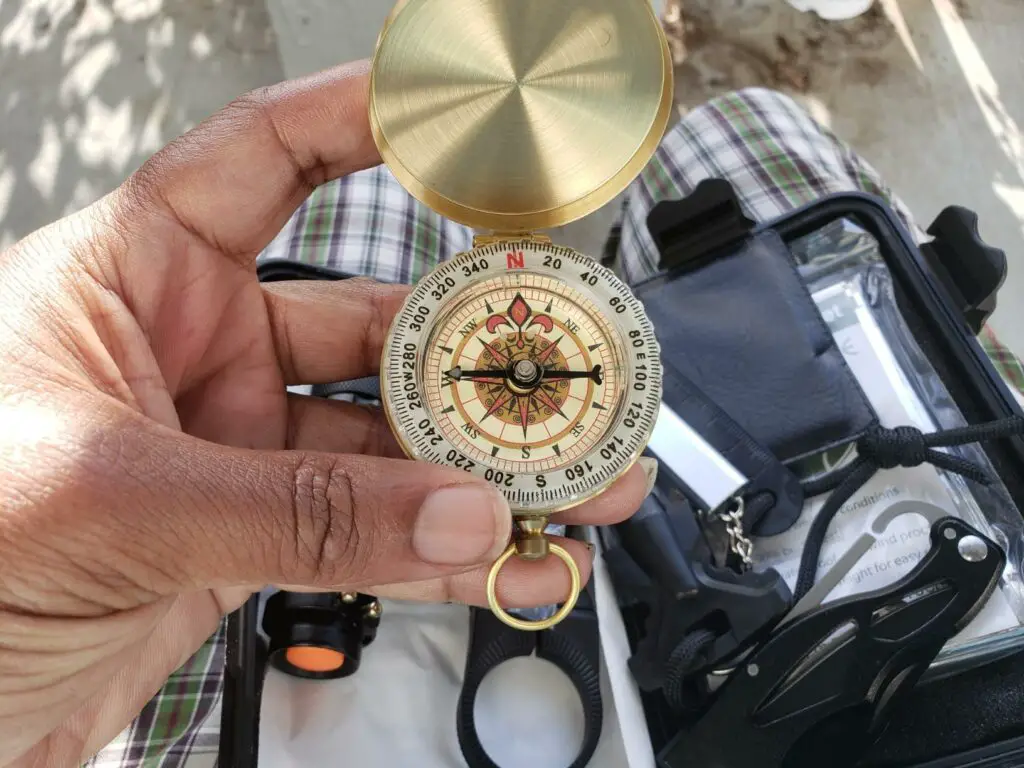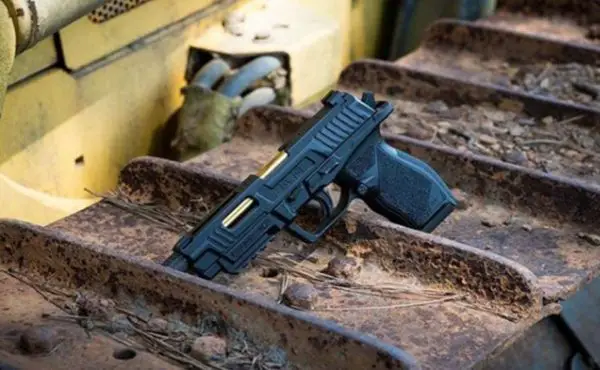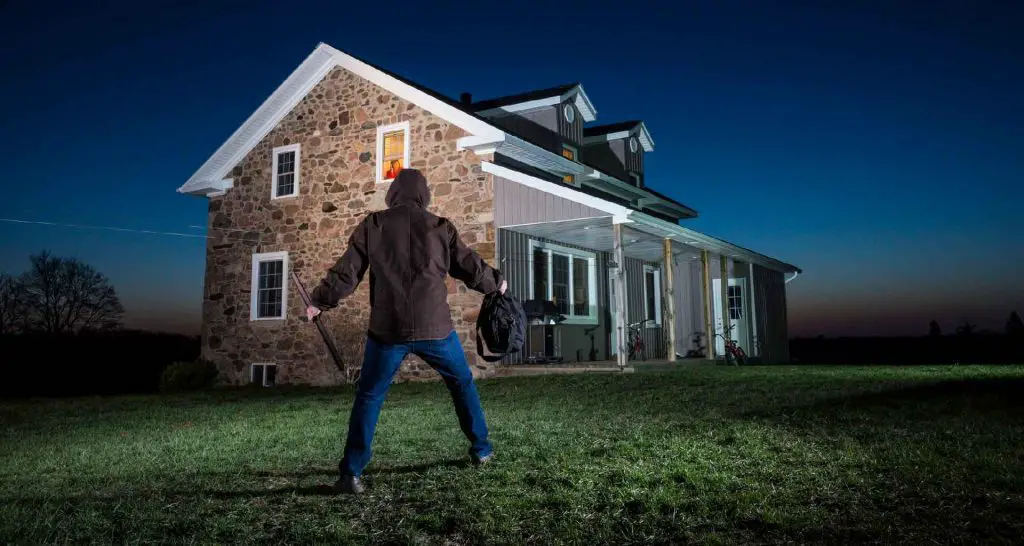
Home Defense 101: Preparing For a Home Intruder
We hear frightening home invasion statistics on radio ads and see them online day after day, and yet nobody ever believes that they’ll become part of that statistic.
Home defense is important because while those statistics can seem inflated and fear-inducing, they’re real. Over 4,000 home invasions happen in the United States every single day, making up over 1,000,000 home invasions per year.
It’s time to shift the statistics in the other direction. It’s time to learn how to protect your home, devise a home defense plan from the ground up, and implement it so that you’re always ready when invaders prey on your home and your family.
Let’s get started.
Creating a Home Defense Plan
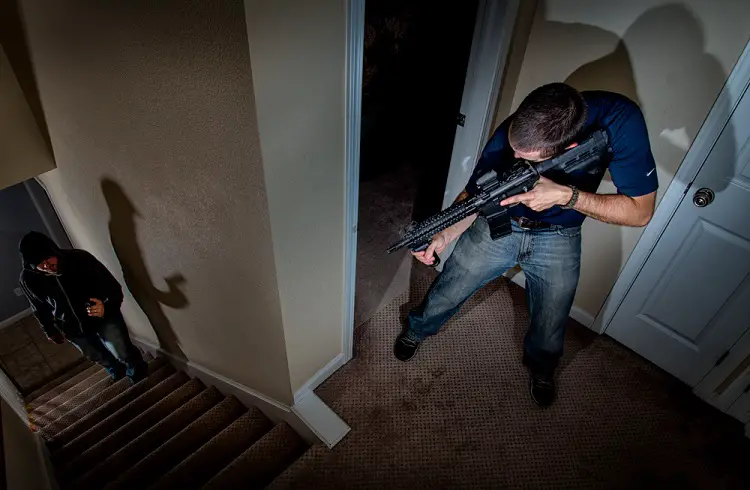
You have to look at your home as if you’re someone who wants to rob it, and then go through every single way that you would rip it off.
Is the home interesting? Is it fortified? Is it easy to hide in the dark (bushes, barrels, etc.)?
There’s a lot you have to look at.
I know; it can make anyone’s head spin when you think about every possibility, so let’s break it down piece by piece, and plan out a complete home defense plan right now. By the end of this article, you’ll know how to protect your family better than most people out there.
Prevention
It all starts here. If we can all avoid an intruder making their way into our homes in the first place, we’ve achieved the best home defense possible. There are a few things you can do to prevent thieves from even taking interest in your home in the first place.
However, if you have a nicer home than others in the neighborhood, or you don’t want to let the possibility of invaders ruin your ability to make your home look glorious, you can still defend yourself properly.
Have Visible Warning Signals for the Invader (e.g., CCTV Cameras)
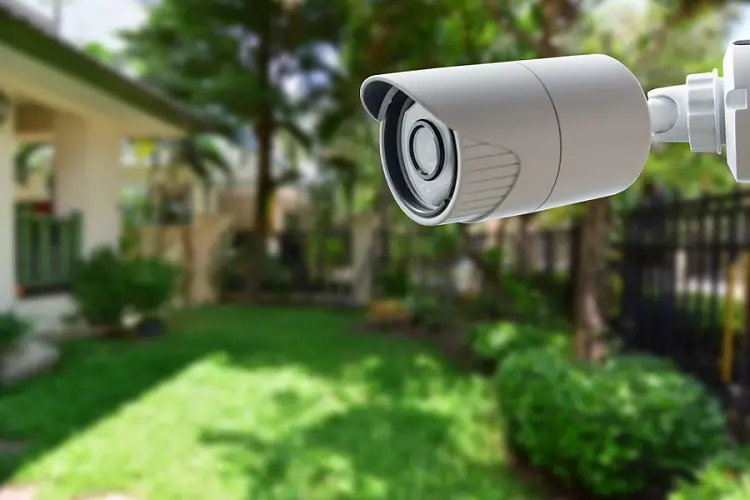
Do you have any idea how many people buy ADT signs off of Amazon and don’t actually have home security installed?
A lot. There’s a reason that there’s a joke about it in popular movies and shows like Mindhunter, because people actually do this all the time.
But the secret’s out, isn’t it?
The sign isnt going to prevent anyone from breaking into your home, because most thieves and criminals know that it’s likely to be false. You need warning signals, not signs.
A warning signal should effectively force a potential thief to think “I shouldn’t even try to rob this house.” This includes:
- CCTV cameras positioned at all entry points (doors and windows) as well as leading up your driveway, or looking at the street; at that point they’ve already been seen taking interest in your home
- A clean exterior (power wash your siding from time to time) shows them that you take care of your home, and while some may perceive this as a bad thing, it tells thieves that you pay attention to what’s going on and look for small details
- An actual home security system, not just a sign; these work like car alarms in crowded parking lots by bringing immediate attention to the thieves and rousing suspicion from anyone around, whether that’s the homeowner, neighbors, or passers-by
Prevention is the first step. The statistics on just how effective these methods are is difficult to obtain, because nobody says “I almost robbed a house once’ in any conversation. That being said, it’s easy to understand what is and isn’t enticing to a thief.
You need to turn your home into a bad idea for any potential intruder to even consider.
Don’t Broadcast Travels on Social Media
Social media is a thief’s best friend. As detection and prevention technology gets better, career criminals match the same tenacity. If you’re going away on vacation for any length of time, there are a very few select people that you should inform.
Do not go to Facebook or Instagram and declare that you are going away on vacation. While on vacation, you can take videos and photos, but do not post them until you return home. Geotagging, which is when you tag your photo location, lets people know that you’re not at home. Thieves may even be able to identify where you live based on publicly available information.
If you do go on vacation, consider installing a smart hub in your home with smart bulbs. These can go on and off at sporadic times, or during normal times, and while it may cost you a little bit on your electricity bill, it will emulate you being home even if you’re on vacation. No lights being on in your home for three days may rouse interest.
Have a Dog
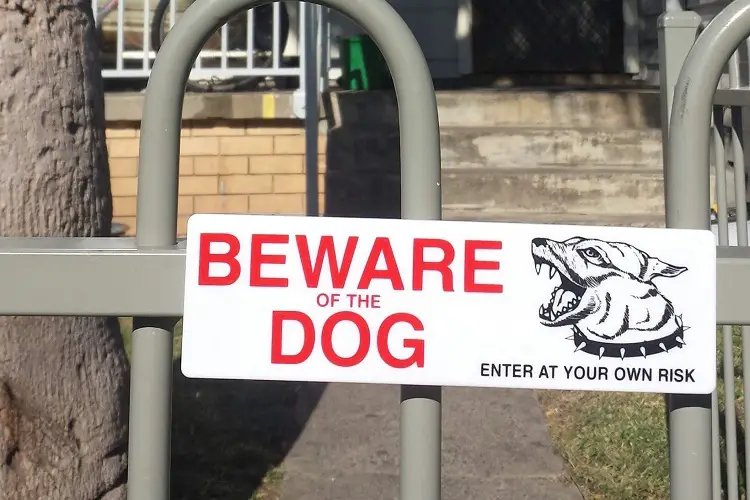
You don’t have to have a rottweiler to have a home defense pup. Dogs don’t want anyone in your home that doesn’t belong, and while many of us are heavy sleepers, we’ll likely wake up when the dog starts barking in the living room at two in the morning.
Any dog that’s big enough to injure someone will likely scare off a thief. They not only risk being harmed and knowing that the homeowner is now being woken up, but if a dog chases them down, their escape route will be compromised as well.
Clear Your Surroundings
The outside of your home is either a deterrent, or something that will attract thieves. It all depends on how you set it up. A messy yard tells an intruder that you don’t care about your home, that you’re not aware of what’s going on within or around it, and opens you up to be a target. It also gives them plenty to hide behind if they decide that you’re their next victim.
Clear out your yard, remove shrubbery that’s close to your home, and give them nothing to hide behind. But how are they going to know if you have a clear yard when it’s the middle of the night?
Keep it well-lit. Flood lights on a maintained lawn, in a yard with no debris, tall grass, shrubbery, or anything else obstructing the home, will be the best way to deter thieves.
Preparation
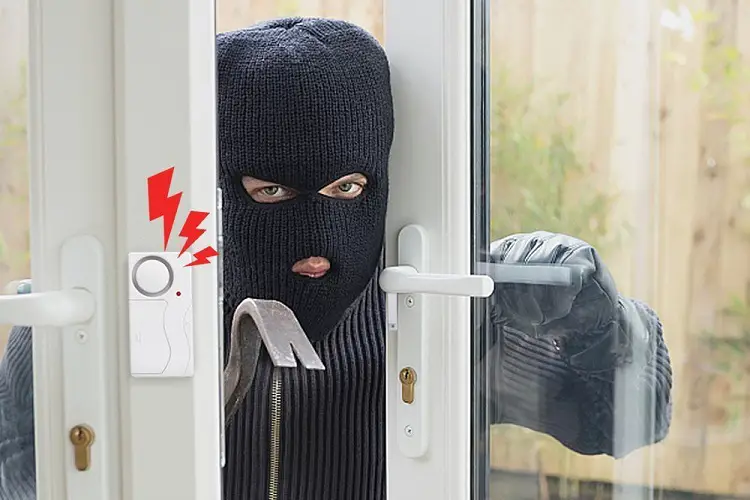
Home defense is something you have to actively work at. Once you set up a proper prevention method, you have to prepare to encounter more tenacious thieves and intruders.
In this section, we’re going to talk about the more intricate methods of self-defense in the home and what you need to do to ensure your family is protected.
Identify High-Risk Areas in Your House
High-risk areas in your home could be spots that allow intruders to hide, narrow corridors that you could get trapped in if an assailant has a weapon, and anywhere that danger is most likely to lurk.
It doesn’t take long for a thief (or anyone, for that matter) to identify an entryway or living room. But they’re less likely to know where the bedrooms are, or where a spare room is, bathrooms, etc.
That means that once they enter the home, they’re going to start figuring out where these spots are. Your high-risk areas are those with the most traffic and most entry points.
When we talk about planning escape routes later on in this guide, we’re going to address the fact that you need to plan escapes in areas that aren’t obvious. Make sure your preparation plan accounts for the most high-risk areas in your home.
Have a Safe Room
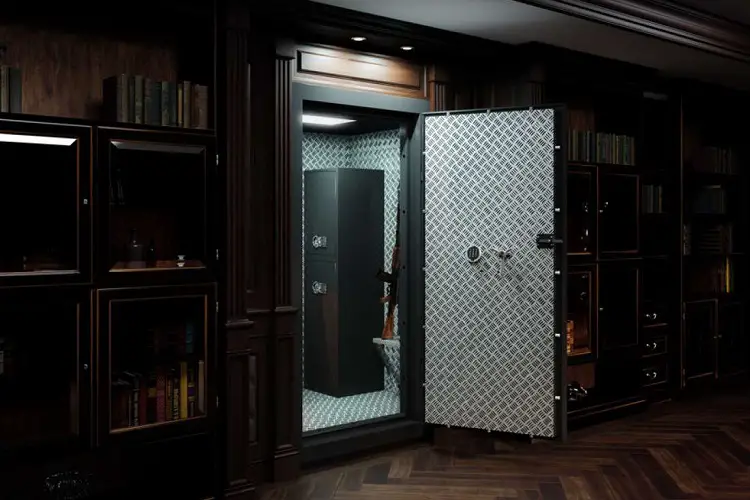
Safe rooms don’t have to be $8,000 steel door, professional installed spaces in your home. That being said, those are some of your best options.
You need someplace safe that assailants can’t enter. A safe room should have a few requirements:
- Strong, sturdy doors that cannot be broken down
- Shatterproof glass windows
- A first-aid kit
- Form of communication with authorities
- Self-defense weapon of some sort
If you’re not going to feel any safer closing the door, then it’s not a safe room. This should be somewhere that you
Prepare an Escape Route
In the event that you can’t design a proper safe room, or you aren’t able to reach it, you need to have at least one escape route to safely bring you and your family away from the home before any harm can come to you.
Escape routes should be direct, concise, and provide the fastest route to safety.
If intruders enter the living room, which room is farthest away from them, and which room can lead to a safe place? Is it near the garage so you can use the car to get away? Is it on the edge of your property so you can cross into another yard or disappear into the street/into the woods nearby?
Know the Laws of Your Area
When it comes to self-defense, your state may not be too privy to giving you the freedom you deserve. In the event that an intruder enters your home, you need to know absolutely everything that you’re lawfully allowed to do to prevent them from bringing harm to your or your family.
Some state laws are very backwards and can really screw you over in the long run. Important laws to research on include firearm ownership, gun storage, and even on self-defense. Did you know that in most states in the US, it is illegal to fire a warning shot?
Understand the laws for your state, but also inspect your local municipality laws. It’s difficult to act accordingly when an intruder breaks into your home, but the last thing anyone needs is to be put in a difficult legal situation because they were trying to defend themselves.
Be Realistic With Your Skills and Capabilities

Be honest with yourself. Are you in the best shape? Do you know how to use a gun effectively? How do you handle tough or stressful situations?
You have to answer these questions. It might be a difficult conversation with yourself, but this may be the time to take a class on self-defense, go back to the gym, and spend a little more time at the range each month to ensure that you stay nice and sharp.
Be honest, because every one of us could stand to sharpen our skills. Do what you can to learn how to handle situations under pressure if that’s something you currently struggle with.
Home Defense Strategies
Now it’s time to talk about what you can actually do to defend your home, or rather, defend your family and yourself if you become targeted by home intruders.
We’re going to discuss your ability to barricade yourself in, arm yourself, and contact the authorities among other things.
This is the most important part of this guide, because if you cannot prevent an invader from entering your home, you have to handle how you respond to them.
Evade
Completely avoid intruders at all costs. Everywhere you look, listen, or read, you’re going to find this bit of advice. Even if you’re confident, do not approach intruders.
Evade and escape above all else. We’re going to discuss using firearms in a moment, but it’s still not a smart idea to approach invaders.
Arm

You should be armed in the event that you must resort to this option. However, we talked about local laws and restrictions earlier, and those come up again here.
Self-defense is defined differently in different states, usually only varying by small details, but sometimes it’s those small details that come into play when you’re facing the back-end of an issue like this.
Do not approach. Stay armed if you are in danger, but do not go looking for the invader with your weapon. This is critical for your own safety, but also for the safety of your family, and to remain out of legal trouble.
Barricade
If you don’t have a safe room with a locking door, use what you can to barricade yourself in a room that is not easily accessible. For instance, a second story bedroom with one door and one window. This gives you an escape route, but also cuts off an entry point to any intruders that intend to harm you.
Most of the time, intruders are there for goods, but if anyone is home and makes a scene, they may resort to violence. Barricading yourself into a room is one of your best lines of defense as long as you can escape, or if you can contact authorities from within the room.
Communicate With Authorities
Have a cell phone and be sure it’s always charged. If you hear a home intruder, grab it immediately.
In the event that you enter a safe room or barricade yourself into a specific room in your home, you need a way to call for help. While it may take the authorities some time to get there, as long as the invader can’t get to you, you should be okay.
Respond
If you have to respond to the situation, then you have to. An intruder breaks in, and you are close by. You have to respond to the situation.
However, you do not have to respond to the intruder. In fact, you shouldn’t at all, because it may personalize the experience and make them assume violent responses are the immediate solution to their situation.
Home Defense Gun
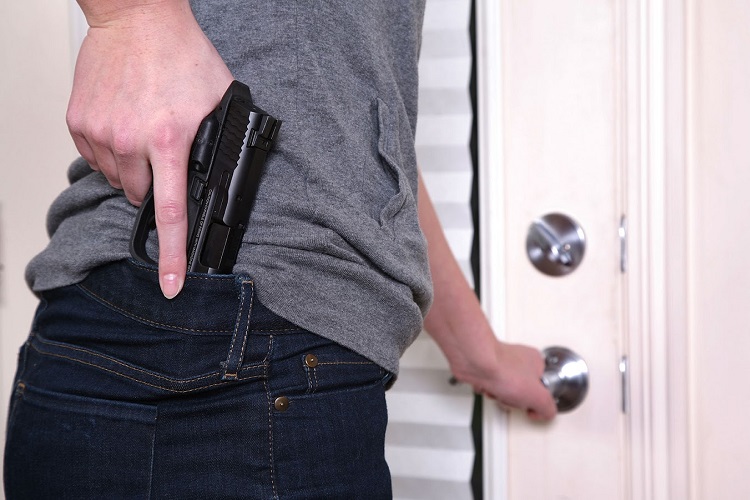
Let’s say that your situation means that you have to resort to self-defense with a weapon.
Well, what weapon do you pick? And how do you pick it? Is it based on your home, or your personal capability? Let’s talk about that.
Choosing a Gun
Your goal when buying a gun for home defense is to find something that will disable or disarm an intruder. The goal is not to kill on sight; you just want to get to safety. This choice will show law enforcement and possibly a legal team what your intent was.
Gunning down an invader with multiple shots from a high caliber weapon, like an AR-15, is overkill compared to shooting an assailant in the leg or the stomach with a 9MM pistol.
Why? Because the power of the gun you choose shows intent, or at least it can be perceived that way. The gun you choose needs to show the intent of self-defense.
Handgun vs. Shotgun
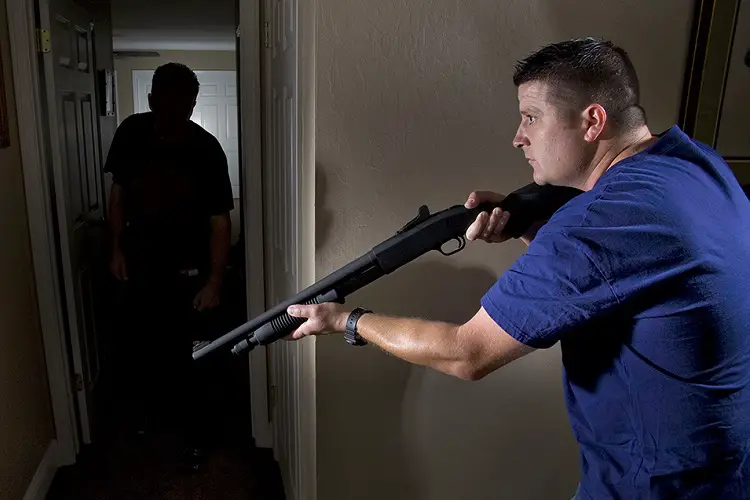
Handguns are portable, easier to grab, and don’t have the same power as a shotgun. Is a shotgun still a good self-defense weapon? Yes, because it’s good for nervous shooters, and depending on the caliber of the shot you choose (buckshot vs. slugs), it will be more user-friendly.
If your sole reason for buying a gun is home defense, that’s okay. Just know your limit and what you will be most effective with. Shotguns and high-powered handguns, such as revolvers, have more kickback than a 9MM, and are much more difficult to use.
For the average person, a pistol is enough. For those with firearm training and the ability to stay calm under pressure, shotguns may be the better option.
Read Also: 5 Pistol Shooting Drills for Home Defense
Novice
For a novice, it’s important to stick to guns that can be easily controlled with minimal kickback. The less powerful a weapon feels in the hands of a novice, the less intimidating it will be to use it.
You still have to make sure that the firearm you choose is effective enough to ward off an intruder, but a 9MM pistol is usually the go-to, or a .22 snub nose.
Experienced Shooter
An experienced shooter will be more comfortable with a shotgun or high caliber pistol, but with that higher level of skill, something small and swift like a 9MM pistol will still be extremely powerful in their capable hands.
Depending on experience, it comes down to preference, but with the option to choose higher caliber weapons and still be effective.
If you want to look more into buying the best home defense gun for you, check out these articles
- What’s the Best Home Defense Firearm: Shotgun, Rifle, or Handgun?
- Shotgun vs AR15
- Shotgun vs Rifle
- Home Defense Shotgun Ammo
Storing Home Defense Gun Properly
Guns are subject to damage when improperly stored. Moisture is their enemy. You want to keep guns in a dry, safe location such as a gun safe.
If you don’t own a gun safe, you can read our guide here. It showcases the differences between a gun safe and a gun cabinet to know which you need. However, if you’re going with something high caliber like a shotgun or rifle, you’ll need a larger gun safe.
Besides the gun safe storage, you should also think about the location of where you’ll be putting your guns and whether to keep your handgun loaded or unloaded in the safe.
Imagine you wake up in the middle of the night, and you hear shuffling downstairs. Do you have time to get your gun from the bedside table and load it with your ammo? Do you have time to go downstairs to the garage where your gun safe might be?
Where you store your firearms depends on your living situation. And as much as we want to recommend keeping your guns loaded for quick usage when a threat comes, there are state specific laws for gun storage – especially if there are kids in the house. Make sure to research and consider these as well!
Cleaning Your Home Defense Gun
If your firearm is just for peace of mind and is rarely used, then you only need a light maintenance. The bare minimum would be to do a field strip, dry wipe, and light oil once a year.
But if we’re being honest, even if you’re only keeping a gun for home defense, use it. Go out to the range and practice with it. Learn how to use it so if the worst case comes, you’ll be prepared.
We have several guides you can check out for gun cleaning:
Home Defense Without Guns
There are some people who really don’t want to keep a gun in the house, and that’s okay. There are still ways you can ward off an attacker by causing them pain without inflicting potentially mortal bodily harm.
Machete or Knife

I don’t know about you, but if someone comes at me with a machete, I’m going to be pretty intimidated by them. Machetes are inexpensive and flashy ways to show your intent to protect yourself.
When it comes to knives, you run into an issue with blade length laws. Smaller knives will look less intimidating, and if you’re using a means of self defense that isn’t a gun, half of the aim should be to intimidate the invader into running away before anyone gets hurt.
Pepper Spray or Mace Gun
While it doesn’t look particularly intimidating, pepper spray is one of the most effective and powerful ways that you can defend yourself without a gun.
You can read information about pepper spray and be knowledgeable;e on how to use it in a short amount of time. It’s one of the most accessible means of non-lethal force that you can get in your hands within a few days.
Paintball Gun
If you ever did paintballing as a teenager, then you know that paintballs hurt when they hit you. An intruder isn’t going to be wearing paintball gear like padding, so when they get hammered with a barrage of paintballs, it’s going to hurt them pretty bad.
Keep in mind that paintball guns need C02 to run, and need to be stored in safe spaces with little to no moisture. These will be lightweight in your hands, and forgiving if you end up missing some of your shots. It’s enough to cause immense pain to an assailant and allow your family the time to go through a pre-planned escape route.
Blunt Objects

Batons, or Billy Clubs, are used as non-lethal force by police in many parts of the world. You can buy steel batons, which will cause an immense amount of pain to an intruder, or use a baseball bat. Hockey sticks are only a good option if they’re metal, otherwise they’re prone to snapping with enough force.
Boat Horn or Air Horn
While this isn’t as effective as the other options, using an air horn and keeping pressure on the button can cause enough pain to an invader’s ears that they will curl over in pain. This isn’t a bad idea to have in your non-lethal self-defense arsenal, but it should not be your primary means of home defense.
Flashlight
Having a tactical flashlight sounds like it won’t do much, but there are flashlights with sharp bezels, SOS flash modes, and high lumen outputs to temporarily blind an invader. Depending on the output and what is allowed by law, you could permanently blind an invader with enough direct, focused light.
Fire Extinguisher
Blunt objects, such as fire extinguishers, are powerful enough to knock out an assailant. This is something you have to get really close to the invader to use, so it’s not recommended, but if it’s all you have at your disposal then that’s what you have to deal with.
For a more comprehensive pros and cons of non lethal home defense weapons, you can check this out.
Home Defense for Women

Women are often the victims of home invasion more than men, especially when living alone. Women can defend themselves in the following way:
- Handguns are your best option for self-defense weapons, as well as pepper spray
- Tactical flashlights can help blind an opponent that may assume you are weak
- Do not use earphones or talk on the phone when entering or exiting your home (violent offenders who may invade your home look for distracted females)
- Utilize outdoor lights to show that you’re aware of your surroundings and fend off potential intruders
- Keep blinds drawn and curtains closed; you don’t want to show anyone who may be watching your home that you are alone (this may give them the nerve to break in)
- Utilize more than one lock per door, and be sure to lock your windows
- Keep an open floor plan and put mirrors in key areas of your home so that you can always be aware of what’s ahead of you
Home Defense for Families With Children
When children are thrown into the mix, a home invasion is infinitely more terrifying. This is what you can do:
- Your first goal is securing a safe space for your family to stay, that means securing a safe room before you do anything else
- Inform your children about the possibility of home invaders in a safe way that isn’t scary, and go through practice drills with them
- Teach your children about noises in the middle of the night and what they can do about it, and explain what not to do
- Invaders typically do not enter homes when they know there are children present out of the increased risk of jail time (threatening the life of a child is far more damaging to their appeals in court)
- Develop a safety plan that includes you being able to go to all of your children’s bedrooms before moving to a safe room
- When planning your home defense strategy in your home, make sure your kids have a bedroom close to yours, giving you a shorter path to their bedroom to make sure they are okay
Read Also: A Parent’s Guide to Securing Guns at Home and How to Teach Gun Safety to Kids
Home Defense for Seniors

Senior citizens have a harder time defending themselves. The best way to keep everything safe and defend yourself as a senior citizen are:
- Only perform outside tasks during broad daylight, whether that’s bringing the trash to the curb or raking up the yard
- Bright lights and security cameras will be instrumental in warding off intruders in the first place; use these to your advantage
- Keep pepper spray on hand at all times in either a purse or a front pocket
- Learn martial arts depending on your physical capability level (there are classes for all capability levels)
- Park your car in the garage, not on the driveway or in the road
Home Defense for Small Apartments
Apartments put you at a disadvantage for escape routes, which is why you need to focus on the following:
- Strengthen your doors and lock your windows
- Use a tactical flashlight in conjunction with a firearm
- Keep a clear pathway from your bedroom to the front door
- If you’re bringing expensive purchases home, such as a TV or a laptop, keep the packaging concealed until you enter your apartment
- Request adding an additional lock (may be subject to landlord/company restrictions)
- Have the ability to barricade your bedroom door if need be
- Always keep emergency self-defense in an easy-to-reach spot
Home Defense is in Your Control
At the end of the day, your home defense is up to you to control. Not being prepared is like welcoming intruders into your home and letting them do whatever they want.
Your home is your domain. Yours to protect. Now that you know what you need to do, it’s time to get equipped to do so.
Follow our guides on finding the best home defense tactical gear and knowing how to use it. You can never be too prepared when it comes to the safety and wellbeing of you and your family.
